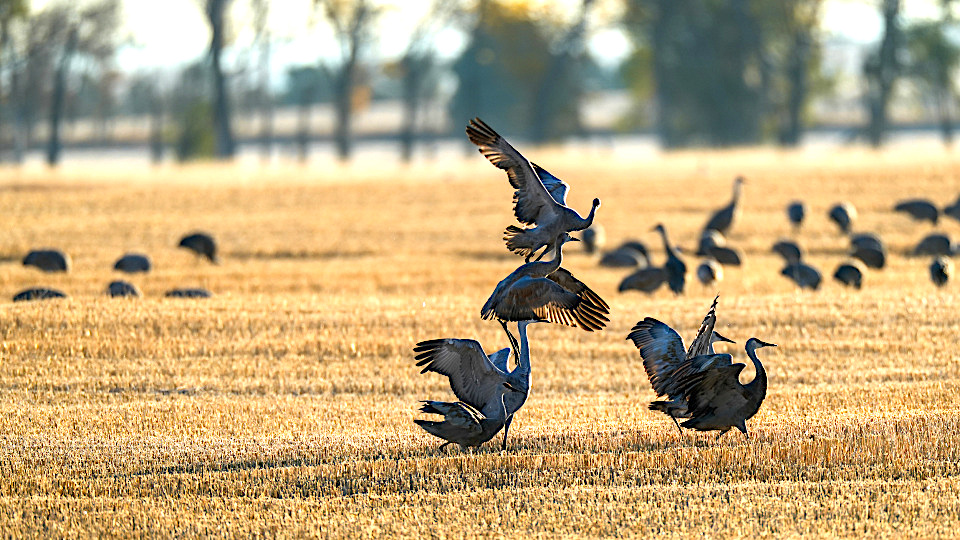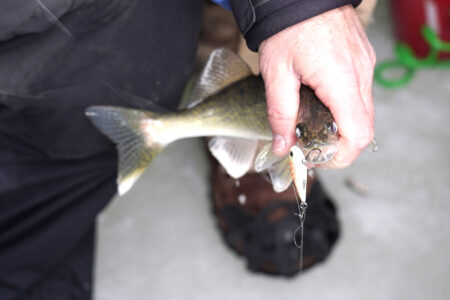North Dakota Outdoors: Sandhill crane: Over looked, under appreciated

Submitted Photo There are four populations of sandhill cranes that migrate through the United States — Rocky Mountain, Lower Colorado River, Eastern and Mid-continent. Photo from NDGF.
Have you ever been sandhill crane hunting? Not just a chance opportunity when a few sandhills drifted through while goose or duck hunting. If you haven’t I’d suggest it might be a new or different way to enjoy North Dakota outdoors this fall. Here’s a little more information about these overlooked and under appreciated migrants.
About sandhill cranes
John Palarski, North Dakota Game and Fish Department migratory game bird biologist explains: “There are four populations of sandhill cranes that migrate through the United States — Rocky Mountain, Lower Colorado River, Eastern and Mid-continent.”
The latter population of birds are those that color North Dakota’s skies gray in spring and fall, and to the pedestrian looking for, say, color or size differences between one group to the next, there’s not much to distinguish one population of sandhills from the others.
Most are differentiated just by where they are breeding and where their migratory paths take them.
“What’s interesting about the Mid-continent population of sandhill cranes is that they have four main breeding affiliations or areas where they’re breeding,” Palarski said. “Some of those birds go up to western Alaska and eastern Siberia to nest, while some go into eastern Alaska and western Canada. Another group goes to far northern Canada, and the fourth breeding affiliation is kind of in that northwestern Minnesota area and eastern and central Canada as well.”
North Dakota is an incredibly important stopover site for cranes making long-haul migrations to breeding grounds.
“What the cranes are looking for in North Dakota are our shallow wetlands where they can rest and refuel,” Palarski said.
“Considering that some of these birds are migrating a couple thousand miles to places like Siberia, Alaska and northern Canada, North Dakota plays a key role during their migration.”
The menu to refuel for the long flight north is diverse for these birds.
“Sandhill cranes are technically omnivorous. While we think of them eating a lot of grains, wetland seeds, vegetation, wetland plant tubers … they’re also known to eat amphibians, reptiles and small mammals as well,” Palarski said.
Cranes mate for life, biologists tell us, and hang with their dancing partner year-round.
“Typically, their clutch size is two. The chicks will leave the nest and begin foraging right after hatching,” Palarski said. “But it takes around 65 to 75 days for them to actually fledge and be able to fly.”
While North Dakota and its Central Flyway location plays a key role in helping shuttle cranes from wintering to breeding grounds in spring, the list of sandhills reportedly nesting in North Dakota over time is not long. Much of that has to do with an absence of large, shallow marshes, or bogs, in North Dakota that the cranes prefer for nesting.
“North Dakota has an affiliation with birds breeding in northwestern Minnesota, so we’ll still have birds that occasionally drift over into North Dakota to nest,” Palarski said.
Crane hunting 101
Sandhill crane hunting is an often-overlooked option in North Dakota. These underappreciated visitors through North Dakota are very unique. Not just in size, sight and taste.
Their early September migration from Canada in North Dakota provides a different option between early Canada goose and regular waterfowl for hunters. The few thousand hunters each fall are part of a niche group. While small in numbers the draw for sandhill crane hunting can be less competition and congestion.
While the “flyings sticks” look like an easy target, crane hunters are all too familiar with the long necks and keen eyesight flaring many a flock. Most hunters choose a heavy load and magnum option to help balance the odds for efficient, clean kills taken from longer distances.
These birds are notorious for roosting and feeding in different locations. Just because you scout a field in the evening doesn’t mean they’ll use the same feed for a morning decoy hunt.
Space won’t permit the full disclosure on cleaning, preparing and eating. I will say that I’ve made and eaten crane stir fry and jerky with a few other culinary experiments, all of which were better table fare than “roast crane.”
A look at crane hunting In North Dakota
1984 – 3,189 hunters, 4,367 cranes harvested
1994 – 2,497 hunters, 6,235 cranes harvested
2004 – 2,491 hunters, 3,967 cranes harvested
2014 – 1,743 hunters, 2,924 cranes harvested
2023 – 3,029 hunters, 5,419 cranes harvested



